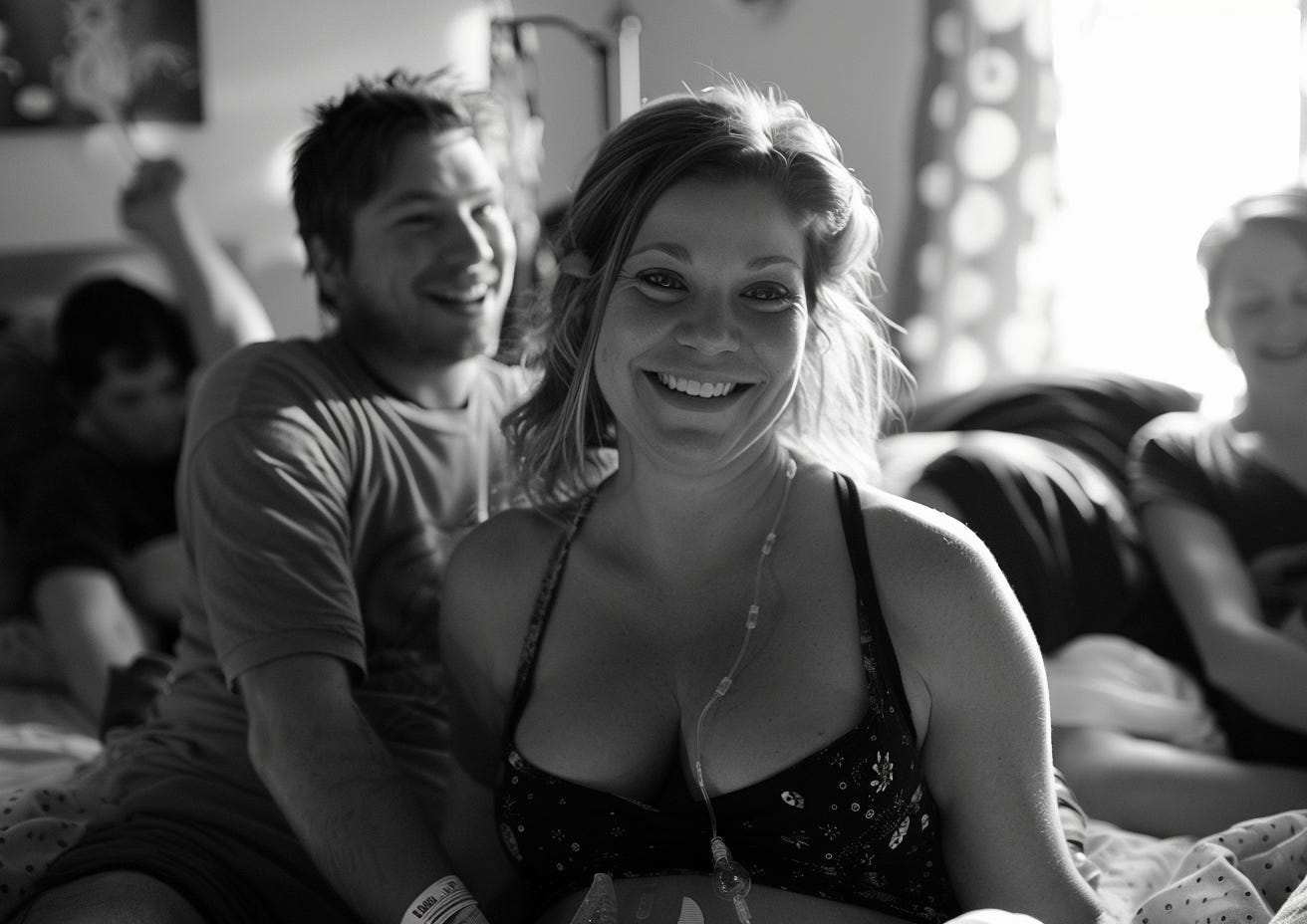All four of my children were born at home. I feel extremely fortunate about this - they should too. Four wonderful experiences. I will forever be in debt to Louisa and Jolie.
When, twenty-four years ago, my then wife, Louisa, told me she wanted to give birth to our first child at home, I thought she was off her rocker, but I gave her my word that we would at least talk to a midwife, and we did just that. Within about five minutes of meeting Tina Perridge of South London Independent Midwives, a lady of whom I cannot speak highly enough, I was instantly persuaded.
Ever since, when I hear that someone is pregnant, I start urging them to have a homebirth with the persistence of a Jehovah’s Witness or someone pedalling an upgrade to your current mobile phone subscription.
I even included a chapter about it in my first book Life After the State - Why We Don’t Need Government (2013), (now, thanks to the invaluable help of my buddy Chris P, back in print - with the audiobook here [Audible UK, Audible US, Apple Books]).
I’m publishing that chapter here, something I was previously not able to do (rights issues), because I want as many people as possible to read it. Many people do not even know home-birth is an option.
I’m fully aware that, when it comes to giving birth, one of the last people a prospective mum wants to hear advice from is comedian and financial writer, Dominic Frisby. I’m also aware that this is an extremely sensitive subject and that I am treading on eggshells galore. But the word needs to be spread. All I would say is that if you or someone you know is pregnant, have a conversation with an independent midwife, before committing to having your baby in a hospital. It’s so important. Please just talk to an independent midwife first.
With that said, here is that chapter. Enjoy it, and if you know anyone who is pregnant, please send this to them.
We have to use fiat money, we have to pay taxes, most of us are beholden in some way to the education system. These are all things much bigger than us, over which we have little control. The birth of your child, however, is one of the most important experiences of your (and their) life, one where the state so often makes a mess of things, but one where it really is possible to have some control.
The State: Looking After Your First Breath
The knowledge of how to give birth without outside interventions lies deep within each woman. Successful childbirth depends on an acceptance of the process.
Suzanne Arms, author
There is no single experience that puts you more in touch with the meaning of life than birth. A birth should be a happy, healthy, wonderful experience for everyone involved. Too often it isn’t.
Broadly speaking, there are three places a mother can give birth: at home, in hospital or – half-way house – at a birthing centre. Over the course of the 20th century we have moved birth from the home to the hospital. In the UK in the 1920s something like 80% of births took place at home. In the 1960s it was one in three. By 1991 it was 1%. In Japan the home-birth rate was 95% in 1950 falling to 1.2% in 1975. In the US home-birth went from 50% in 1938 to 1% in 1955.1 In the UK now 2.7% of births take place at home. In Scotland, 1.2% of births take place at home, and in Northern Ireland this drops to fewer than 0.4%.2 Home-birth is now the anomaly. But for several thousand years, it was the norm.
The two key words here are ‘happy’ and ‘healthy’. The two tend to come hand in hand. But let’s look, first, at ‘healthy’. Let me stress, I am looking at planned homebirth; not a homebirth where mum didn’t get to the hospital in time.
My initial assumption when I looked at this subject was that hospital would be more healthy. A hospital is full of trained personnel, medicine and medical equipment. My first instinct against home-birth, it turned out, echoed the numerous arguments against it, which come from many parts of the medical establishment. They more or less run along the lines of this statement from the American College of Obstetrics and Gynaecology: ‘Unless a woman is in a hospital, an accredited free-standing birthing centre or a birthing centre within a hospital complex, with physicians ready to intervene quickly if necessary, she puts herself and her baby’s health and life at unnecessary risk.’3
Actually, the risk of death for babies born at home is almost half that of babies born at hospital (0.35 per 1,000 compared to 0.64), according to a 2009 study by the Canadian Medical Association Journal. The National Institute for Health and Clinical Excellence reports that mortality rates are the same in booked home-birth as in hospitals.4 In November 2011 a study of 65,000 mothers by the National Perinatal Epidemiology Unit (NPEU) was published in the British Medical Journal. The overall rate of negative birth outcomes (death or serious complications) was 4.3 per 1,000 births, with no difference in outcome between non-obstetric and obstetric (hospital) settings. The study did find that the rate of complications rose for first-time mums, 5.3 per 1,000 (0.53%) for hospitals and 9.5 per 1,000 (0.95%) for home-birth. I suspect the number of complications falls with later births because, with experience, the process becomes easier – and because mothers who had problems are less likely to have more children than those who didn’t. The Daily Mail managed to twist this into: ‘First-time mothers who opt for home birth face triple the risk of death or brain damage in child.’ Don’t you just love newspapers? Whether at home or in the hospital there were 250 negative events seen in the study: early neonatal deaths accounted for 13%; brain damage 46%; meconium aspiration syndrome 20%; traumatic nerve damage 4% and fractured bones 4%. Not all of these were treatable.
There are so many variables in birth that raw comparative statistics are not always enough. And, without wishing to get into an ethical argument, there are other factors apart from safety. There are things – comfort, happiness, for example – for which people are prepared to sacrifice a little safety. The overriding statistic to take away from that part of the study is that less than 1% of births in the UK, whether at hospital or at home, lead to serious complications.
But when you look at rates of satisfaction with their birth experience, the numbers are staggering. According to a 1999 study by Midwifery Today researching women who have experienced both home and hospital birth, over 99% said that they would prefer to have a home-birth in the future!
What, then, is so unsatisfying about the hospital birth experience? I’m going to walk through the birthing process now, comparing what goes on at home to hospital. Of course, no two births are the same, no two homes are the same, no two hospitals are the same, but, broadly speaking, it seems women prefer the home-birth experience because: they have more autonomy at home, they suffer less intervention at home and, yes, it appears they actually suffer less pain at home.5
When mum goes into labour, the journey to the hospital, sometimes rushed, the alien setting when she gets there, the array of doctors and nurses who she may never have met before, but are about to get intimate, can all upset her rhythm and the production of her labour hormones. These aren’t always problems, but they have the potential to be; they add to stress and detract from comfort.
At home, mum is in a familiar environment, she can get comfortable and settled, go where she likes and do what she likes. Often getting on with something else can take her mind off the pain of the contractions, while in hospital there is little else to focus on. At home, she can choose where she wants to give birth – and she can change her mind, if she likes. She is in her own domain, without someone she doesn’t know telling her what she can and can’t do. She can change the light, the heating, the music; she can decide exactly who she wants at the birth and who ‘catches’ her baby. She can choose what she wants to eat. She will have interviewed and chosen her midwife many months before, and built up a relationship over that time. But in hospitals she is attended by whoever is on duty, she has to eat hospital food, there might be interruptions, doctors’ pagers, alarms, screams from next door, whirrs of machinery, tube lighting, overworked, resentful staff to deal with, internal hospital politics, people coming in, waking her up, and checking her vitals, sticking in pins or needles, putting on monitor belts, checking her cervix mid-contraction – any number of things over which mum has no control. Mums who move about freely during labour complain less of back pain. Many authorities feel that the motion of walking and changing positions can even enhance the effectiveness of the contractions, but such active birth is not as possible in the confines of many hospitals. Many use intravenous fluids and electronic foetal monitors to ensure she stays hydrated and to record each contraction and beat of the baby’s heart. This all dampens mum’s ability to move about and adds to any feelings of claustrophobia.
In hospital the tendency is to give birth on your back, though this is often not the best position – the coccyx cannot bend to help the baby’s head pass through. There are many other positions – on your hands and knees for example – where you don’t have to work against gravity and where the baby’s head is not impeded. On your back, pushing is less effective and metal forceps are sometimes used to pull the baby out of the vagina, but forceps are less commonly used when mum assumes a position of comfort during the bearing-down stage.
This brings us to the next issue: intervention. The NPEU study of 2011 found that 58% of women in hospital had a natural birth without any intervention, compared to 88% of women at home and 80% of women at a midwife-led unit. Of course, there are frequent occasions when medical technology saves lives, but the likelihood of medical intervention increases in hospitals. I suggest it can actually cause as many problems as it alleviates because it is interruptive. Even routine technology can interrupt the normal birth process. Once derailed from the birthing tracks, it is hard to get back on. Once intervention starts, it’s hard to stop. The medical industry is built on providing cures, but if you are a mother giving birth, you are not sick, there is nothing wrong with you, what you are going through is natural and normal. As author Sheila Stubbs writes, ‘the midwife considers the miracle of childbirth as normal, and leaves it alone unless there’s trouble. The obstetrician normally sees childbirth as trouble; if he leaves it alone, it’s a miracle.’6
Here are just some of the other interventions that occur. If a mum arrives at hospital and the production of her labour hormones has been interrupted, as can happen as a result of the journey, she will sometimes be given syntocinon, a synthetic version of the hormone oxytocin, which occurs naturally and causes the muscle of the uterus to contract during labour so baby can be pushed out. The dose of syntocinon is increased until contractions are deemed normal. It’s sometimes given after birth as well to stimulate the contractions that help push out the placenta and prevent bleeding. But there are allegations that syntocinon increases the risk of baby going into distress, and of mum finding labour too painful and needing an epidural. This is one of the reasons why women also find home-birth less painful.7
Obstetricians sometimes rupture the bag of waters surrounding the baby in order to speed up the birthing process. This places a time limit on the labour, as the likelihood of a uterine infection increases after the water is broken. Indeed in a hospital – no matter how clean – you are exposed to more pathogens than at home. The rate of post-partum infection to women who give birth in hospital is a terrifying 25%, compared to just 4% in home-birth mothers.8 Once the protective cushion of water surrounding the baby’s head is removed (that is to say, once the waters are broken) there are more possibilities for intervention. A scalp electrode, a tiny probe, might be attached to baby’s scalp, to continue monitoring its heart rate and to gather information about its blood.
There are these and a whole host of other ‘just in case’ interventions in hospital that you just don’t meet at home. As childbirth author Margaret Jowitt, says – and here we are back to our theme of Natural Law – ‘Natural childbirth has evolved to suit the species, and if mankind chooses to ignore her advice and interfere with her workings we must not complain about the consequences.’9
At home, if necessary, in the 1% of cases where serious complications do ensue, you can still be taken to hospital – assuming you live in reasonable distance of one.
‘My mother groaned, my father wept,’ wrote William Blake, ‘into the dangerous world I leapt.’ We come now to the afterbirth. Many new mothers say they physically ache for their babies when they are separated. Nature, it seems, gives new mothers a strong attachment desire, a physical yearning that, if allowed to be satisfied, starts a process with results beneficial to both mother and baby. There are all sorts of natural forces at work, many of which we don’t even know about. ‘Incomplete bonding,’ on the other hand, in the words of Judith Goldsmith, author of Childbirth Wisdom from the World’s Oldest Societies, ‘can lead to confusion, depression, incompetence, and even rejection of the child by the mother.’10 Yet in hospitals, even today with all we know, the baby is often taken away from the mother for weighing and other tests – or to keep it warm, though there is no warmer place for it that in its mother’s arms (nature has planned for skin-to-skin contact).
Separation of mother from baby is more likely if some kind of medical intervention or operation has occurred, or if mum is recovering from drugs taken during labour. (Women who have taken drugs in labour also report decreased maternal feelings towards their babies and increased post-natal depression). At home, after birth, baby is not taken from its mother’s side unless there is an emergency.
As child development author, Joseph Chilton Pearce, writes, ‘Bonding is a psychological-biological state, a vital physical link that coordinates and unifies the entire biological system . . . We are never conscious of being bonded; we are conscious only of our acute disease when we are not bonded.’11 The breaking of the bond results in higher rates of postpartum depression and child rejection. Nature gives new parents and babies the desire to bond, because bonding is beneficial to our species. Not only does it encourage breastfeeding and speed the recovery of the mother, but the emotional bonding in the magical moments after birth between mother and child, between the entire family, cements the unity of the family. The hospital institution has no such agenda.
The cutting of the umbilical cord is another area of contention.12 Hospitals, say home-birth advocates, cut it too soon. In Birth Without Violence, the classic 1975 text advocating gentle birthing techniques, Frederick Leboyer – also an advocate of bonding and immediate skin-to-skin contact between mother and baby after birth – writes:
[Nature] has arranged it so that during the dangerous passage of birth, the child is receiving oxygen from two sources rather than one: from the lungs and from the umbilicus. Two systems functioning simultaneously, one relieving the other: the old one, the umbilicus, continues to supply oxygen to the baby until the new one, the lungs, has fully taken its place. However, once the infant has been born and delivered from the mother, it remains bound to her by this umbilicus, which continues to beat for several long minutes: four, five, sometimes more. Oxygenated by the umbilicus, sheltered from anoxia, the baby can settle into breathing without danger and without shock. In addition, the blood has plenty of time to abandon its old route (which leads to the placenta) and progressively to fill the pulmonary circulatory system. During this time, in parallel fashion, an orifice closes in the heart, which seals off the old route forever. In short, for an average of four or five minutes, the newborn infant straddles two worlds. Drawing oxygen from two sources, it switches gradually from the one to the other, without a brutal transition. One scarcely hears a cry. What is required for this miracle to take place? Only a little patience.
Patience is not something you associate with hospital birth. There are simply not the resources, even if, as the sixth US president John Quincy Adams said, ‘patience and perseverance have a magical effect before which difficulties disappear and obstacles vanish’. The arguments to delay the early cutting of the cord (something not as frequent in hospitals as it once was) are that, even though blood going back to the placenta stops flowing – or pulsing – non-pulsing blood going from the placenta into baby is still flowing. After birth, 25–35% of baby’s oxygenated blood remains in the placenta for up to ten minutes. With the cord cut early, baby is less likely to receive this blood, making cold stress, infant jaundice, anaemia, Rh disease and even a delayed maternal placental expulsion more likely. There is also the risk of oxygen deprivation and circulatory shock, as baby gasps for breath before his nasal passages have naturally drained their mucus and amniotic fluid. Scientist W. F. Windle has even argued that, starved of blood and oxygen, brain cells will die, so cutting the cord too early even sets the stage for brain damage.13
Natural birth advocates say it is vital for the baby’s feeding to be put to the breast as soon as possible after birth, while his sucking instincts are strongest. Bathing, measuring and temperature-taking can wait. Babies are most alert during the first hour after birth, so it’s important to take advantage of this before they settle into that sleepy stage that can last for hours or even days.
Colostrum, the yellow fluid that breasts start producing during pregnancy, is nature’s first food. is substance performs many roles we know about and probably many we don’t as well. Known as ‘baby’s first vaccine’, it is full of antibodies and protects against many different viruses and bacteria. It has a laxative effect that clears meconium – baby’s black and tarry first stool – out of the system. If this isn’t done, baby can be vulnerable to jaundice. Colostrum lines baby’s stomach ready for its mother’s milk, which comes two or three days later, and it meets baby’s nutritional needs with a naturally occurring balance of fat, protein and carbohydrate. Again, with the various medical interventions that go on in hospitals, from operations to drug-taking to simply separating mother and baby, this early breast-feeding process can easily be derailed. Once derailed, as I’ve said, it’s often hard to get back on track. I am no scientist and cannot speak with any authority on the science behind it all, but I do know that nature, very often, plans for things that science has yet to discover.
Once upon a time, when families lived closer together and people had more children at a younger age, there was an immediate family infrastructure around you. People were experienced with young. If mum was tired, nan or auntie could feed the baby. Many of us are less fortunate in this regard today. With a hospital, you are sent home and, suddenly, you and your partner are on your own with a baby in your life, and very little aftercare. When my first son was born I was 30. I suddenly realized I had only held a baby once before. I was an only child so I had never looked after a younger brother or sister; my cousins, who had had children, lived abroad. Suddenly there was this living thing in my life, and I didn’t know what to do. But, having had a home-birth, the midwife, who you already know, can you give you aftercare. She comes and visits, helps with the early breastfeeding process and generally supports and keeps you on the right tracks.
It’s so important to get the birthing process right. There are all sorts of consequences to our health and happiness to not doing so. And in the West, with the process riddled as it is with intervention, we don’t. We need to get birth out of the hospital and into an environment where women experience less pain, lower levels of intervention, greater autonomy and increased satisfaction.
A 2011 study by a team from Peking University and the London School of Hygiene found that, of 1.5 million births in China between 1996 and 2008, babies born in hospitals were two to three times less likely to die. China is at a similar stage in its evolutionary cycle to the developed world at the beginning of the 20th century. The move to hospitals there looks inevitable. Something similar is happening in most Developing Nations.
In his book A History of Women’s Bodies, Edward Shorter quotes a doctor describing a birth in a working-class home in the 1920s:
You find a bed that has been slept on by the husband, wife and one or two children; it has frequently been soaked with urine, the sheets are dirty, and the patient’s garments are soiled, she has not had a bath. Instead of sterile dressings you have a few old rags or the discharges are allowed to soak into a nightdress which is not changed for days.
For comparison, he describes a 1920s hospital birth:
The mother lies in a well-aired disinfected room, light and sunlight stream unhindered through a high window and you can make it light as day electrically too. She is well bathed and freshly clothed on linen sheets of blinding whiteness . . . You have a staff of assistants who respond to every signal . . . Only those who have to repair a perineum in a cottars’s house in a cottar’s bed with the poor light and help at hand can realize the joy.14
Most homes in the developed world are no longer as he describes, if they ever were, except in slums. It would seem the evolution in the way we give birth as a country develops passes from the home to the hospital. It is time to take it away from the hospital.
Why am I spending so much time on birth in a book about economics? The process of giving birth is yet another manifestation of this culture of pervasive state intervention. (Hospitals, of course, are mostly state run.) It’s another example of something that feels safer, if provided by the state in a hospital, even if the evidence is to the contrary. And it’s another example of the state destroying for so many something that is beautiful and wonderful.
What’s more, like so many things that are state-run, hospital birth is needlessly expensive. The November 2011 study of 65,000 mothers by the National Perinatal Epidemiology Unit looked at the average costs of birth in the NHS. They were highest for planned obstetric unit births and lowest for planned home-births. Here they are:
£1,631 (c. $2,600) for a planned birth in an obstetric unit
£1,461 (c. $2,340 for a planned birth in an alongside midwifery unit (AMU)
£1,435 (c. $2,300) for a planned birth in a free-standing midwifery unit (FMU)
£1,067 (c. $1,700) for a planned home-birth.15
Not only is it as safe; not only are people more satisfied by it; not only do the recipients receive more one-to-one – i.e. better – care; home-birth is also 35% cheaper. Intervention is expensive.
So I return to this theme of non-intervention, whether in hospitals or economies. It often looks cruel, callous and hard-hearted; it often looks unsafe, but, counter-intuitively perhaps, in the end it is more human and more humane.
When you look at the cost of private birth, the argument for home-birth is even more compelling. Private maternity care is expensive. For example, in summer 2012, a first birth at the Portland Hospital in London costs £2,880 (about $4,400) for a normal delivery and £3,790 (about $5,685) for an elective caesarean and for the first 24 hours of care. Additional nights in a standard room cost around £1,000 (about $1,500). You also have to allow for the fees charged by your private consultant obstetrician, which might be £3,000–£4,000 ($4,500– $6,000). So, in total, a private birth at a hospital such as the Portland could cost £7,500–£10,000 ($10–$15,000). There will be some saving if you opt for a ‘midwife-led delivery service’ or ‘midwife-led care’. In this instance, you will still have a named obstetrician, but he or she will see you less often, and the birth may be ‘supported by an on-call Consultant Obstetrician’. London midwives charge £2,500–£4,000 (c. $4–6,000) for about six months of care from early pregnancy to a month after birth. The comparative value is astounding, I would say.
To have a planned home-birth on the NHS is possible, but can be problematic to arrange, depending on where you are based. Most people, after they have paid taxes, do not now have the funds to buy a private home-birth, so they are forced into the arms of government health care, such is the cycle at work.
I was first introduced to the idea of home-birth by my ex-wife, Louisa, something for which I will forever be grateful. She hated hospitals due to an earlier experience in her life and only found out about alternatives thanks to the internet. I, as well as my friends and family, thought Louisa was insane. But she insisted. And she was right to.
Our first son was actually two weeks and six days late. Because he was so late, we were obliged to go to the hospital, which we did, after two weeks and five days. We were kept waiting so long in there, we decided to go and persuaded an overworked nurse that we were fine to go and we left. The confused nurse was glad to have one less thing to think about. The next day Samuel was born: a beautiful and wonderful experience that I will never forget, one of the happiest days of my life – exactly as nature intended.
Simply talking to people that have experienced both home-birth and hospital birth, or reading about their experiences, the anecdotal evidence is compelling. Home-birth may not be for everyone – I’m not suggesting it is. Birthing centres seem a good way forward. But a hospital birth should only be for emergencies. Childbirth is a natural process that no longer requires hospitalization, except in those 1% of situations where something goes seriously wrong. If it does go wrong and there is an emergency, call an ambulance and be taken to hospital – that is what they are for.
Returning to the original premise of Natural and Positive Law, it’s pretty clear which category hospital birth falls into. Hospitals do things in the way that they do because of the pressures they are under, not least the threat of legal action should some procedural failure occur. Taking birth back home and away from the state reduces the burden of us on it and of it on us.
Life After the State - Why We Don’t Need Government (2013) is now back in print - with the audiobook here: Audible UK, Audible US, Apple Books.
Tina Cassidy, Birth (New York: Atlantic Monthly Press, 2006), 54–5.
Guardian, ‘Home Birth: What the Hell Was I Thinking?’,16 April 2011.
American Congress of Obstetricians and Gynecologists (ACOG), ‘ACOG Statement on Home Births’. 20 July 2010. http://www.medscape.com/viewarticle/725383 [Accessed 1 June 2013].
National Collaborating Centre for Women’s and Children’s Health, Final Draft of Guideline on Intrapartum Care (London: Royal College of Obstetricians and Gynaecologists, 22 March 2007).
See J. M. Morse and C. Park, ‘Home Birth and Hospital Deliveries’, Research in Nursing and Health, 11, 3 (1988): 175–81.
Sheila Stubbs, Birthing the Easy Way (Privately published, 2005).
Morse and Park, ‘Home Birth and Hospital Deliveries’, 175–81.
G. Chamberlain and A. Wraight, eds, Home Births (Informa Healthcare, 1997).
Margaret Jowitt, Childbirth Unmasked (Self Publishing Association, March 1993).
Judith Goldsmith, Childbirth Wisdom from the World’s Oldest Societies (East West Health Books, 1990).
Joseph Chilton Pearce, Magical Child (Bantam Books, 1980), 63.
See Jock Doubleday, Spontaneous Creation, vol. 2, chapter 74: http://www.whale.to/a/doubleday.html [accessed 1 June 2013].
Quoted in Laura Kaplan, ‘Unassisted Childbirth’, Scientific American, 77 (1969), 31.
Quoted in Edward Shorter, Women’s Bodies (Transaction Publishers, 1982), 156.
National Perinatal Epidemiology Unit, ‘Birthplace in England’ (Oxford, November 2011). ‘These figures include all NHS costs associated with the birth itself – for example midwifery care during labour and immediately after the birth, the cost of any medical care and procedures needed in hospital, and the cost of any stay in hospital, midwifery unit, or neonatal unit immediately after the birth either by the mother or the baby. The costs for planned home and midwifery unit births take account of interventions and treatment that a woman may receive if she is transferred into hospital during labour or after the birth. The costs do not include any longer-term costs of care’.













